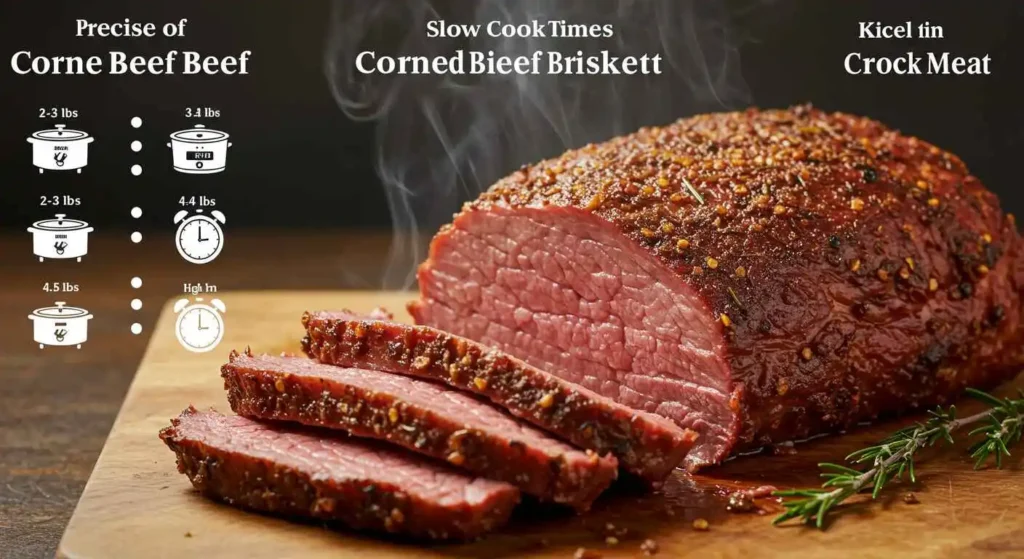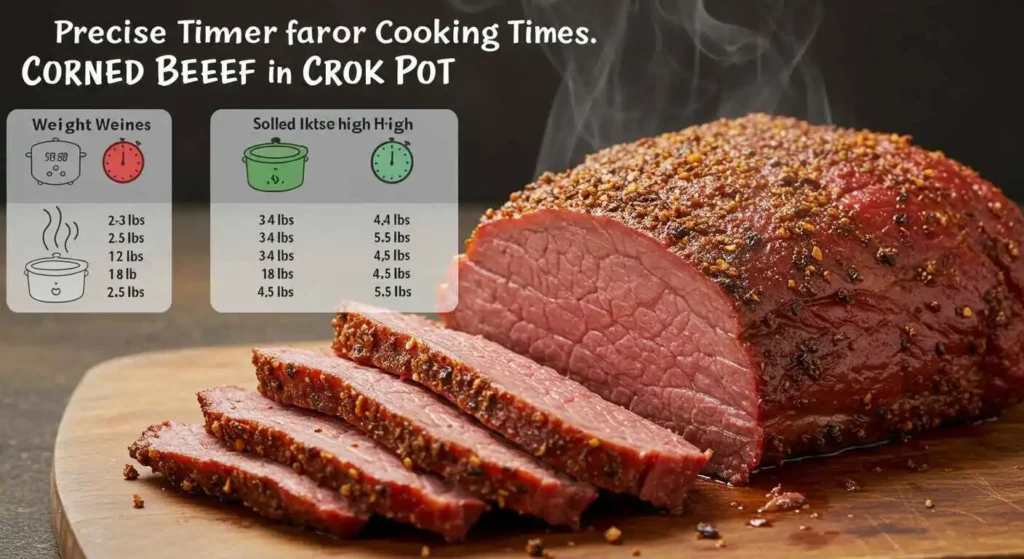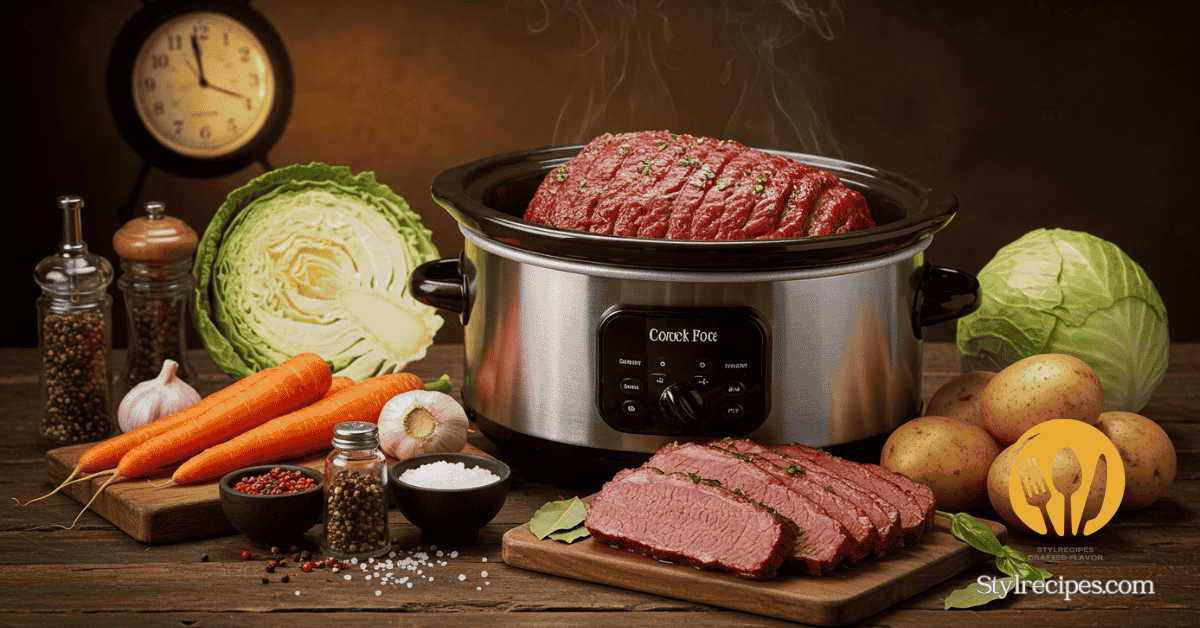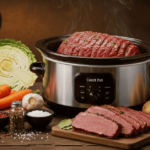There’s something deeply comforting about walking into your home after a long day and being greeted by the rich aroma of corned beef slowly simmering in your crock pot. The anticipation builds as the savory scent fills every corner, promising a meal that will satisfy both body and soul. But perhaps you’ve stood in your kitchen, package of corned beef in hand, wondering exactly how long this particular cut needs to transform from tough to tender perfection.
You’re certainly not alone in this culinary quandary. The journey to mastering slow-cooked corned beef comes with its share of questions and occasional mishaps. Whether you’re preparing for St. Patrick’s Day festivities or simply craving this classic comfort dish, understanding the precise timing for cooking corned beef in a crock pot can make all the difference between a memorable meal and a disappointing dinner.
Let’s demystify the process together and ensure your next corned beef adventure results in that coveted fork-tender texture that practically melts in your mouth.
Table of Contents
What is Corned Beef? Understanding the Basics
The Origins of Corned Beef
Contrary to what the name might suggest, corned beef contains no actual corn. The term “corned” dates back centuries, referring to the large rock salt kernels (once called “corns” of salt) used to preserve meat before refrigeration existed. This curing process not only extended the shelf life of beef but also created the distinctive flavor profile we’ve come to associate with corned beef.
The dish holds particular cultural significance in Irish-American traditions, especially around St. Patrick’s Day celebrations. Though interestingly, the connection between corned beef and Ireland has more to do with Irish immigrants in America than traditional Irish cuisine itself. When Irish immigrants arrived in America, they discovered that corned beef was more accessible and affordable than their traditional bacon, leading to its adoption as a celebratory dish.
Cuts of Corned Beef
When shopping for corned beef, you’ll typically encounter two main cuts: the flat cut and the point cut, both from the brisket section of the cow.
The flat cut (also called first cut) earns its name from its uniform shape and thickness. This leaner option slices beautifully, making it ideal for presentation-focused meals. Its consistent thickness also contributes to more even cooking, which can be helpful when calculating cooking times.
The point cut, meanwhile, contains more marbled fat running through the meat. While this might make neat slicing more challenging, many flavor enthusiasts prefer this cut precisely because that additional fat renders down during the long cooking process, creating incredibly tender, flavor-packed meat.
Your choice between these cuts affects not just appearance and flavor but also influences optimal cooking duration. The point cut, being fattier, typically benefits from slightly longer cooking times to allow that marbling to fully render and work its magic throughout the meat.
Essential Equipment for Slow Cooking Corned Beef
Choosing the Right Crock Pot

While any slow cooker can technically cook corned beef, certain features will elevate your results from good to extraordinary. Size matters significantly when selecting a crock pot for corned beef. As a general guideline, a 6-7 quart slow cooker provides ideal space for a standard family-sized corned beef brisket plus the traditional accompanying vegetables.
Temperature consistency represents another crucial factor in your equipment selection. Premium slow cookers maintain steadier temperatures throughout the cooking chamber, eliminating hot spots that might cook portions of your meat unevenly. Models featuring programmable timers prove particularly valuable, allowing you to set precise cooking durations based on your specific cut’s weight.
Some advanced models include probe thermometers that monitor the internal temperature of your meat continuously, taking the guesswork out of determining doneness. Though not strictly necessary, this feature provides tremendous peace of mind, especially for newcomers to slow cooking.
Additional Tools for Success
A quality meat thermometer ranks as perhaps the most essential complementary tool for perfect corned beef. Digital instant-read versions offer superior accuracy compared to analog options. Despite the conventional wisdom about slow cookers being foolproof, checking the internal temperature remains the only definitive way to confirm your corned beef has reached that ideal 195°F sweet spot.
For serving, invest in a proper carving knife with a long, thin blade. This specialized tool enables you to slice across the grain cleanly, maximizing tenderness in each bite. The difference between properly and improperly sliced corned beef can be startling—even perfectly cooked meat can seem tough when cut incorrectly.
Complete Cooking Time Chart for Corned Beef in Crock Pot
Timing Based on Weight
Understanding precisely how long to cook corned beef in a crock pot based on its weight eliminates much of the uncertainty from the process. Reference this comprehensive timing chart for reliable results:
| Weight of Corned Beef | Cooking Time on Low | Cooking Time on High | Internal Temperature |
|---|---|---|---|
| 2-3 pounds | 8-9 hours | 4-5 hours | 195°F |
| 3-4 pounds | 9-10 hours | 5-6 hours | 195°F |
| 4-5 pounds | 10-12 hours | 6-7 hours | 195°F |
| 5-6 pounds | 12-14 hours | 7-8 hours | 195°F |
Remember these times serve as guidelines rather than absolute rules. Several variables influence the precise duration needed for your specific situation.
Factors That Affect Cooking Time
The thickness of your particular cut significantly impacts cooking duration. A thicker brisket naturally requires additional time for heat to penetrate to its center. This explains why two briskets of identical weight might need different cooking times—their thickness could vary considerably.
Starting temperature plays another crucial role. Meat straight from the refrigerator needs longer to reach safe cooking temperatures compared to meat that’s had 30 minutes to approach room temperature (though food safety experts generally recommend limiting room temperature time to reduce bacterial growth).
Crock pot variations create another variable. Different brands and models operate at slightly different temperature ranges for their “Low” and “High” settings. Once you’ve prepared corned beef in your specific slow cooker, note any adjustments needed from the standard timing chart for future reference.
Those cooking at higher elevations should add approximately 25% more time to the recommended durations. The lower atmospheric pressure at elevation affects how heat transfers through food, necessitating this adjustment.
Step-by-Step Process: How to Cook Corned Beef in a Crock Pot
Preparation Steps
Begin by rinsing your corned beef under cool running water. This simple step removes excess salt from the curing process, preventing your finished dish from becoming overwhelmingly salty. Pat the meat dry thoroughly with paper towels afterward.
The question of whether to trim the fat cap sparks considerable debate among cooking enthusiasts. Leaving some fat in place allows it to melt gradually, basting the meat naturally throughout cooking. However, excessive fat can make the cooking liquid greasy. Consider a compromise approach: trim the fat cap to approximately ¼ inch thickness, preserving flavor while preventing greasiness.
Most corned beef packages include a seasoning packet containing classic pickling spices. While perfectly acceptable, adventurous cooks might create custom blends by adding ingredients like additional bay leaves, juniper berries, or whole allspice. Whatever approach you choose, ensure the seasonings distribute evenly over the meat’s surface.
The Cooking Process
Proper layering in your crock pot creates the foundation for success. Begin with a base layer of chunky vegetables—quartered onions and carrot chunks work beautifully—which serves multiple purposes. This vegetable platform prevents the meat from direct contact with the heating surface while simultaneously flavoring both the cooking liquid and the meat itself.
Speaking of liquid, selecting the right option enhances your finished results dramatically. Water works adequately, but beef broth adds deeper flavor dimensions. For truly transformative results, consider dark beer (particularly stout varieties), which introduces complex malty notes that complement the brisket beautifully.
Position your corned beef fat side up on the vegetable layer. This orientation allows rendered fat to travel downward through the meat during cooking, promoting moisture and flavor throughout the entire cut.
Ensure the lid creates a proper seal with no gaps. Slow cooking relies on creating a consistent temperature environment, which becomes compromised with escaping steam. If your particular lid fits imperfectly, consider wrapping aluminum foil around the gap areas to improve the seal.
Recipe: Classic Slow Cooker Corned Beef and Cabbage
Ingredients
| Ingredients | Amount |
|---|---|
| Corned beef brisket | 4 pounds |
| Baby potatoes | 1 pound |
| Carrots | 4 medium, chopped |
| Onion | 1 large, quartered |
| Cabbage | 1 head, cut into wedges |
| Garlic | 4 cloves, minced |
| Bay leaves | 2 |
| Pickling spice | 1 tablespoon (or included packet) |
| Beef broth | 4 cups |
| Black pepper | 1 teaspoon |

Instructions
- Rinse the corned beef under cold water and pat dry.
- Place onion quarters and carrots at the bottom of your crock pot.
- Position the corned beef fat side up on top of the vegetables.
- Sprinkle the seasoning packet (or your custom blend) over the meat.
- Pour beef broth around (not over) the meat until it reaches about halfway up the sides.
- Add bay leaves and garlic to the liquid.
- Cover and cook on low for 9-10 hours.
- During the final 3 hours, add baby potatoes around the meat.
- In the last hour, arrange cabbage wedges atop everything else.
- Corned beef is ready when it reaches 195°F internally and easily separates with a fork.
How to Tell When Your Corned Beef is Perfectly Done
Visual Indicators
Perfectly cooked corned beef displays several visual cues worth recognizing. The color transforms from bright pink to a deeper, more muted rose hue. While it retains some pinkness (unlike many other cuts of beef), the intensity diminishes noticeably.
The exterior develops a slightly darker appearance than the interior. More importantly, you’ll notice the meat begins pulling away slightly from any visible fat layers—a promising sign that collagen has broken down properly during cooking.
Texture Tests
The classic “fork test” remains the most reliable hands-on method for determining doneness. Insert a fork into the thickest portion of the meat and twist gently. In properly cooked corned beef, the fork should turn with minimal resistance, and the meat fibers should separate easily.
Another indicator appears when lifting the brisket from the cooking liquid. Undercooked meat maintains rigid structural integrity when lifted. Perfectly cooked corned beef, however, shows slight flexibility and might even begin separating along the grain lines when supported at one end.
Using a Meat Thermometer
Despite all visual and texture clues, nothing replaces the precision of temperature verification. The ideal internal temperature for fork-tender corned beef ranges between 190-205°F, with 195°F representing the sweet spot for most cuts.
Insert your thermometer into the thickest portion of the meat, avoiding fat pockets or direct contact with the slow cooker’s surfaces. For the most accurate reading, check multiple spots, as temperatures can vary throughout the cut.
During the final cooking phase, you might notice the internal temperature plateauing temporarily despite continued cooking. This phenomenon, known as “the stall,” occurs as moisture evaporates from the meat’s surface, temporarily cooling it. Patience during this phase rewards you with exceptional tenderness as the plateau breaks and temperature begins rising again.
Common Mistakes to Avoid When Cooking Corned Beef
Overcooking Issues
While slow cookers generally forgive timing imprecision, extreme overcooking creates several unwelcome consequences. The texture deteriorates from tender to mushy, with meat fibers breaking down excessively. This creates an unpleasant mouthfeel rather than the desired tender-but-intact consistency.
Flavor intensity diminishes with extreme overcooking as well. Many flavor compounds eventually break down or evaporate with prolonged heat exposure. Additionally, excessive cooking causes substantial shrinkage as proteins contract and moisture escapes, reducing your yield significantly.
Undercooking Problems
Undercooking creates even more immediate problems. The tough connective tissues in brisket require sufficient time to transform from chewy collagen to silky gelatin. Shortened cooking times leave these tissues partially converted, resulting in a stringy, difficult eating experience regardless of how carefully you slice the meat.
Beyond texture concerns, insufficient cooking time can introduce food safety risks, particularly if the internal temperature hasn’t maintained food-safe minimums long enough to eliminate potential pathogens.
If you discover your corned beef lacks tenderness near mealtime, don’t panic. Transfer it from the slow cooker to a covered baking dish with some cooking liquid, then continue cooking in a 325°F oven. This higher-temperature method accelerates the tenderizing process, potentially saving dinner with another 30-60 minutes of cooking.
Serving Suggestions and Leftover Ideas
Traditional Accompaniments
Cabbage naturally complements corned beef, but preparation methods significantly influence the final result. Rather than cooking cabbage for the entire duration (which results in mushy, overly soft texture), add wedges during only the final 45-60 minutes. This timing creates tender cabbage that retains some structural integrity and vibrant color.
Alongside traditional potatoes, consider serving stone-ground mustard and prepared horseradish. These pungent accompaniments cut through the richness of the meat, creating balanced bites. For a complete flavor experience, include crusty Irish soda bread on the side—its subtle sweetness contrasts beautifully with the savory main dish.
Leftover Transformation
Leftover corned beef transforms magnificently into breakfast hash the following morning. Chop the meat along with any remaining potatoes, add diced onions and bell peppers, then crisp everything in a hot skillet. Top with poached eggs for an unforgettable breakfast experience.
For lunches, thinly sliced cold corned beef makes exceptional sandwiches, particularly when paired with Swiss cheese, sauerkraut, and Russian dressing on rye bread—the classic Reuben combination. The flavor actually improves overnight as the spices continue melding.
Should you find yourself with substantial leftovers, corned beef freezes remarkably well for up to three months. Slice it before freezing for easier portioning later, and store with some cooking liquid to maintain moisture during reheating.
Conclusion
Mastering how long to cook corned beef in a crock pot unlocks one of home cooking’s most satisfying achievements—transforming a humble cut into a celebration-worthy centerpiece. By following the timing chart and techniques outlined above, you’ll achieve that perfect fork-tender texture that defines exceptional corned beef.
Remember that patience truly rewards you when slow cooking this classic dish. Allow the gentle, persistent heat to work its magic over those many hours, transforming tough collagen into luscious gelatin that gives properly cooked corned beef its distinctive mouthfeel and flavor.
Next time you’re planning a family gathering or simply craving soul-satisfying comfort food, reach for that corned beef with confidence. Your slow cooker stands ready to transform it into something truly special, no luck required—just the right timing and techniques.
Why not pick up a corned beef brisket this weekend and put your new knowledge to the test? Share your results with friends and family, and watch as they marvel at your perfectly tender creation. Your crock pot might just become your new favorite culinary tool!
FAQ Section: How Long to Cook Corned Beef in Crock Pot
How long should I cook a 3-pound corned beef in a crock pot?
A 3-pound corned beef requires approximately 8-10 hours on low or 4-5 hours on high in your crock pot. Always verify doneness with a meat thermometer, aiming for that magic 195°F internal temperature that delivers perfect tenderness. Remember that slight variations in thickness and starting temperature might necessitate small adjustments to how long to cook corned beef in a crock pot.
Can I cook corned beef too long in a crock pot?
Yes, excessive cooking times can negatively impact your corned beef. While slow cookers generally forgive timing imprecision better than other methods, cooking beyond 14-16 hours risks transforming your meat from tender to mushy. The collagen that creates that desirable texture eventually breaks down completely, leaving meat fibers without structure. Follow the recommended timing chart for how long to cook corned beef in a crock pot based on your cut’s weight for optimal results.
Should I cook corned beef on high or low in a crock pot?
The low setting typically produces superior results when cooking corned beef. This gentler heat allows collagen to convert to gelatin more gradually and completely, resulting in that prized fork-tender texture. While the high setting works when time constraints exist, the texture difference remains noticeable to discerning palates. The low setting represents the gold standard for how long to cook corned beef in a crock pot when timing permits.
How Long to Cook Corned Beef in Crock Pot: Perfect Timing Chart
Instructions
- Rinse the corned beef under cold water and pat dry.
- Place onion quarters and carrots at the bottom of your crock pot.
- Position the corned beef fat side up on top of the vegetables.
- Sprinkle the seasoning packet (or your custom blend) over the meat.
- Pour beef broth around (not over) the meat until it reaches about halfway up the sides.
- Add bay leaves and garlic to the liquid.
- Cover and cook on low for 9-10 hours.
- During the final 3 hours, add baby potatoes around the meat.
- In the last hour, arrange cabbage wedges atop everything else.
- Corned beef is ready when it reaches 195°F internally and easily separates with a fork.
Notes
- For extra flavor: Add a splash of apple cider vinegar or a bay leaf to the broth.
- For a crispy top: Broil the corned beef for 5 minutes after slow cooking.
- Leftovers: Store in an airtight container in the fridge for up to 4 days or freeze for up to 3 months.


